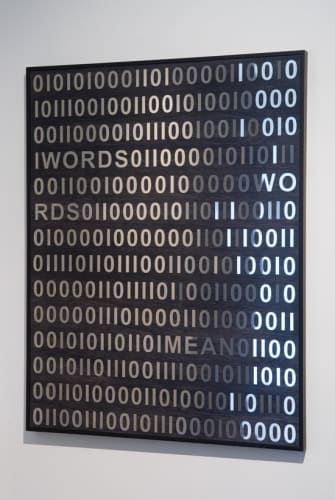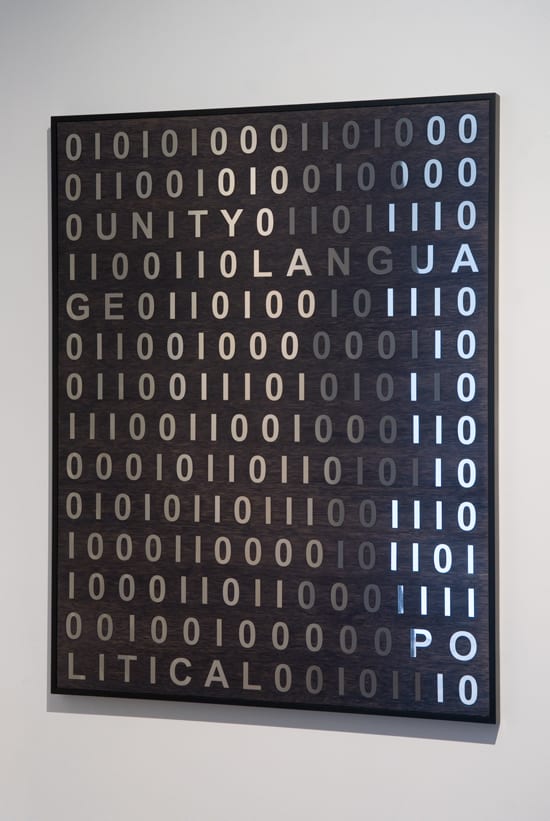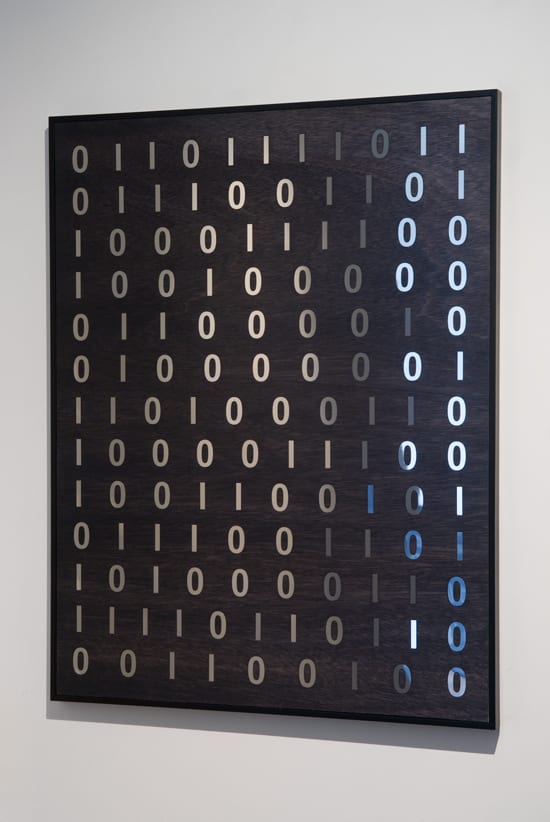Unity
Unity is a visual exploration of two numbers – zero and one – that make up binary code and are the basis for all digital information. Binary code is a system for the representation of reality that uses two symbols that are opposite. It represents words, images, music - everything we engage with digitally. I have been drawn to the minimal beauty of these two symbols that seem in opposition to each other, but through unification become more than the sum of their parts.
The work is an extension of concepts that I began to explore in previous installations, in particular Kryptos (2011) and Codex (2009), both of which examine our complex relationship to language and to codification. These works are also about an essential mystery associated with the process of writing, of recording our thinking about what it is to be in the world. Unity also aims to evoke a sense of mystery, and to reflect on the transformation of the process of writing from analogue to digital. It juxtaposes a series of opposites: numbers and letters, philosophy and mathematics, nature and culture, the organic and inorganic, and the old and the new.
Unity has been inspired by the history of binary code. Some historian relate the emergence of binary code back back to the prosody of Indian Vedic chanting, as outlined by the ancient Indian scholar Pingala, who explains the rhythm of Vedic verse using a binary system of light and heavy syllables. Others establish links between binary code and the ancient Chinese method of divination called the I Ching, or Book of Changes, which is based on interpreting hexagrams of broken or unbroken horizontal lines and the pairing of the opposites yin and yang.
Gottfried Wilhelm Leibniz (1646-1716), a renowned German polymath with particular interests in philosophy and mathematics, is generally accredited with being the father of binary code. He was initially inspired by the I Ching when he developed the system that today forms the basis of all digital computing. An extraordinary scholar, he made significance contributions to many fields of study including physics, probability theory, biology, medicine, geology, philosophy and linguistics. He invented the first mass-produced mechanical calculator, called the Leibniz wheel, and refined the binary number system that we use today. Quotes from his philosophical texts have been incorporated into the digital prints that are part of the Unity exhibition.
There is nothing without a reason.
There are two kinds of truths: those of reasoning and those of fact.
Everything that is possible demands to exist.
The present is pregnant with the future.
We can only see a short distance ahead.
Every substance is as a world apart...
As well as the philosophical statements of Leibniz, the works in Unity incorporate quotes from more contemporary writers that reference our relationship to books, words, writing and knowledge. These include Tasmanian author Richard Flannagan, French writer Marguerite Duras, and the French philosophers Giles Deleuze and Felix Guattari.
There are words and words and none mean anything. (Richard
Flannagan)
The unity of language is fundamentally political. (Deleuze and Guattari)
The self is only a threshold... (Deleuze and Guattari)
The tree imposes the verb “to be”. (Deleuze and Guattari) Around us, everything is writing. (Marguerite Duras)
One is never alone. (Marguerite Duras)
-
 Brigita OzolinsTree, 2016stained and varnished marine ply, sound track and speaker240 x 120 x 60 cm
Brigita OzolinsTree, 2016stained and varnished marine ply, sound track and speaker240 x 120 x 60 cm
Sound: Paul Roberts
Price on Application -
 Brigita OzolinsZero02, Zero01, 2015-2016stained and varnished marine ply, stainless steel, frameddiptych: 105 x 82cm (each panel)Sold
Brigita OzolinsZero02, Zero01, 2015-2016stained and varnished marine ply, stainless steel, frameddiptych: 105 x 82cm (each panel)Sold -
 Brigita OzolinsOne02, One01, 2015-2016diptych: stained and varnished marine ply, stainless steel, frameddiptych: 105 x 82cm (each panel)AU$ 8,000.00
Brigita OzolinsOne02, One01, 2015-2016diptych: stained and varnished marine ply, stainless steel, frameddiptych: 105 x 82cm (each panel)AU$ 8,000.00 -
 Brigita OzolinsAround us, everything is writing, 2015-2016stained and varnished marine ply, stainless steel, framed105 x 82cmSold
Brigita OzolinsAround us, everything is writing, 2015-2016stained and varnished marine ply, stainless steel, framed105 x 82cmSold -
 Brigita OzolinsOne is never alone, 2015-2016stained and varnished marine ply, stainless steel, framed105 x 82cmSold
Brigita OzolinsOne is never alone, 2015-2016stained and varnished marine ply, stainless steel, framed105 x 82cmSold -
 Brigita OzolinsThere are words and words, 2015-2016stained and varnished marine ply, stainless steel, framed105 x 82cmSold
Brigita OzolinsThere are words and words, 2015-2016stained and varnished marine ply, stainless steel, framed105 x 82cmSold -
 Brigita OzolinsThe unity of Language, 2015-2016stained and varnished marine ply, stainless steel, framed105 x 82cmSold
Brigita OzolinsThe unity of Language, 2015-2016stained and varnished marine ply, stainless steel, framed105 x 82cmSold -
 Brigita OzolinsOnly a threshold...(I), 2015-2016stained and varnished marine ply, stainless steel, framed105 x 82cmSold
Brigita OzolinsOnly a threshold...(I), 2015-2016stained and varnished marine ply, stainless steel, framed105 x 82cmSold -
 Brigita OzolinsOnly a threshold...(II), 2015-2016stained and varnished marine ply, stainless steel, framed105 x 82cmSold
Brigita OzolinsOnly a threshold...(II), 2015-2016stained and varnished marine ply, stainless steel, framed105 x 82cmSold -
 Brigita OzolinsLove, 2015inkjet print on Hanhnemule paper, unframed140 x 90cm (paper size) 143.5 x 93.5cm (framed size)AU$ 2,750.00
Brigita OzolinsLove, 2015inkjet print on Hanhnemule paper, unframed140 x 90cm (paper size) 143.5 x 93.5cm (framed size)AU$ 2,750.00 -
 Brigita OzolinsRule XII, 2015inkjet print on Hanhnemule paper, unframed140 x 90cm (paper size) 143.5 x 93.5cm (framed size)edition of 3 plus 1 artist's proofAU$ 2,750.00 + framing
Brigita OzolinsRule XII, 2015inkjet print on Hanhnemule paper, unframed140 x 90cm (paper size) 143.5 x 93.5cm (framed size)edition of 3 plus 1 artist's proofAU$ 2,750.00 + framing -
 Brigita OzolinsRule XXVIII, 2015inkjet print on Hanhnemule paper, unframed140 x 90cm (paper size) 143.5 x 93.5cm (framed size)edition of 3 plus 1 artist's proofAU$ 2,750.00
Brigita OzolinsRule XXVIII, 2015inkjet print on Hanhnemule paper, unframed140 x 90cm (paper size) 143.5 x 93.5cm (framed size)edition of 3 plus 1 artist's proofAU$ 2,750.00 -
 Brigita OzolinsBeing, 2015inkjet print on Hanhnemule paper, unframed140 x 90cm (paper size) 143.5 x 93.5cm (framed size)AU$ 2,750.00
Brigita OzolinsBeing, 2015inkjet print on Hanhnemule paper, unframed140 x 90cm (paper size) 143.5 x 93.5cm (framed size)AU$ 2,750.00 -
 Brigita OzolinsRule XIII, 2015inkjet print on Hanhnemule paper, unframed140 x 90cm (paper size) 143.5 x 93.5cm (framed size)edition of 3 plus 1 artist's proofAU$ 2,750.00
Brigita OzolinsRule XIII, 2015inkjet print on Hanhnemule paper, unframed140 x 90cm (paper size) 143.5 x 93.5cm (framed size)edition of 3 plus 1 artist's proofAU$ 2,750.00 -
 Brigita OzolinsEvery substance is a world apart, 2015inkjet print on Hanhnemule paper, unframed146 x 90cm (paper size) 149 x 93.5cm (framed size)AU$ 2,750.00
Brigita OzolinsEvery substance is a world apart, 2015inkjet print on Hanhnemule paper, unframed146 x 90cm (paper size) 149 x 93.5cm (framed size)AU$ 2,750.00 -
 Brigita OzolinsEvery substance is a world apart, 2015inkjet print on Hanhnemule paper, unframed146 x 90cm (paper size) 149 x 93.5cm (framed size)AU$ 2,750.00
Brigita OzolinsEvery substance is a world apart, 2015inkjet print on Hanhnemule paper, unframed146 x 90cm (paper size) 149 x 93.5cm (framed size)AU$ 2,750.00 -
 Brigita OzolinsWe can only see a short distance ahead, 2015inkjet print on Hanhnemule paper, unframed140 x 90cm (paper size) 143 x 93.5cm (framed size)Sold
Brigita OzolinsWe can only see a short distance ahead, 2015inkjet print on Hanhnemule paper, unframed140 x 90cm (paper size) 143 x 93.5cm (framed size)Sold -
 Brigita OzolinsOM, 2015inkjet print on Hanhnemule paper, unframed146 x 90cm (paper size) 149 x 93.5cm (framed size)AU$ 2,750.00
Brigita OzolinsOM, 2015inkjet print on Hanhnemule paper, unframed146 x 90cm (paper size) 149 x 93.5cm (framed size)AU$ 2,750.00 -
 Brigita OzolinsThere are two kinds of truths, 2015inkjet print on Hanhnemule paper, unframed140 x 90cm (paper size) 143 x 93.5cm (framed size)Sold
Brigita OzolinsThere are two kinds of truths, 2015inkjet print on Hanhnemule paper, unframed140 x 90cm (paper size) 143 x 93.5cm (framed size)Sold -
 Brigita OzolinsThere is nothing without reason, 2015inkjet print on Hanhnemule paper, unframed140 x 90cm (paper size) 143 x 93.5cm (framed size)Sold
Brigita OzolinsThere is nothing without reason, 2015inkjet print on Hanhnemule paper, unframed140 x 90cm (paper size) 143 x 93.5cm (framed size)Sold




















